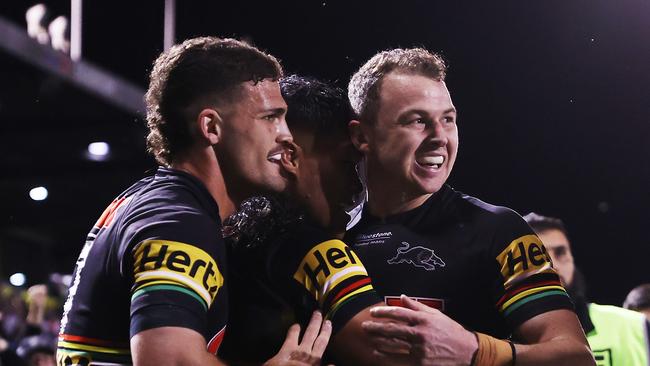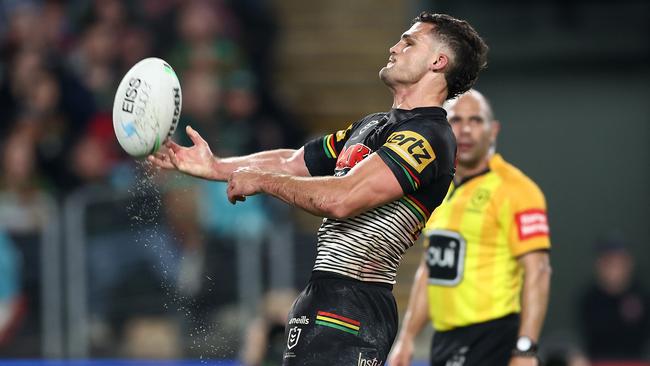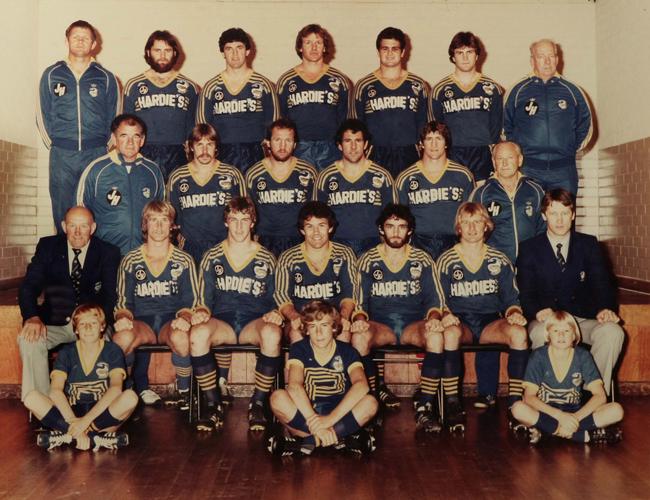NRL grand final 2022: How Penrith Panthers can emulate 1980s Parramatta Eels
Penrith’s surge towards back-to-back premierships should be the blueprint for all clubs – but it’s been a project decades in the making, writes PAUL KENT.

NRL
Don't miss out on the headlines from NRL. Followed categories will be added to My News.
Say this about the Penrith Panthers, they do winning better than just about any team in the modern game, and quite a few in the old game.
They might even be in the early works of creating a little history for themselves.
The days of premiership winners holding the trophy through a collage of changing photos, different jerseys through changing hairstyles with the odd role players changing on the edges, are long gone.
The salary cap makes it too difficult, goes the thinking.
Teams can invest in one or two marquee players but the rest are interchangeable.
This Penrith team is completely different, though. By the time the Panthers say cheese for their final premiership snap Nathan Cleary might be sporting mutton chop sideburns and Jarome Luai might be sporting baggy pants, 1980s style, that look like a band of gypsies could move in and nobody would notice.

For many years the conversation around the game was that the salary cap made it too difficult for teams to even win two in a row until the Sydney Roosters did it in 2018-19, more than 20 years since it was last done.
And they are still the only team to have done it in the NRL era, when the salary became better policed.
This Penrith team is not only odds on to also go back to back as champions, they will be at prohibitive odds to win next season and make it three in a row, for the first time since Parramatta in 1981-83.
It’s a poetic kind of irony that the Eels, this Sunday, have the chance to interrupt Penrith’s run and protect the achievement their club still holds.
These Panthers know how to win, though.
Some could even argue, from a distance, at least, that they are as close in makeup to that Parramatta side as any side has come since.
The Eels had what some might call a perfect blend back then.
Halves Brett Kenny and Peter Sterling were just 20 and 21 in that first premiership. By the time the Eels got their second premiership, which Penrith attempt Sunday, only Mick Cronin was above the age of 23 in the backline, at a wily 31.
Cronin was the general of the backline, four star, and Steve Edge and Ray Price kept the young ones from getting carried away just enough to keep their eyes on what rally mattered, which was winning the trophy.
Cleary and Jarome Luai were 23 and 24 last year. Both are about to play their third grand final.
Dylan Edwards, at 26, is the oldest in the Penrith backline.
And like the Eels, the Panthers are filled with junior stars.
It shows that if teams can get their junior systems right they receive a heavy discount on the salary cap, which can set them up for years.
Kenny, Eric Grothe, Steve Ella, Paul Mares, Paul Taylor, Neil Hunt and Steve Sharp were all Parramatta juniors in that second premiership, while Sterling finished his schooling in the juniors. All young and on the way up.

Penrith’s shrewd development – while they have the biggest junior league in the game, they also spend more on development than any club in the NRL – is paying the kind of benefits now that contributes to overcoming the salary cap.
It should be the blueprint for all teams.
The benefits are many.
As well as creating an artificial discount on the salary cap, players coming through the development system together get a head-start on rivals in terms of the combinations they form.
The greatest advantage a team can have over rivals, according to former Wallaby Ben Darwin’s Gain Line analytics, is time spent together.
Cohesion is often the greatest contributor to success. It naturally builds strength and
rugby league can certainly speak for it.
Dynasties were common within the game for more than half a century.
In the 23 seasons from 1949 to 1971, only two seasons saw the premiership won by a team not called either St George or South Sydney.
That’s a long drought for fans of any other persuasion.
The first time, 1952, Western Suburbs beat Souths to interrupt what would have been a six-year streak for the Rabbitohs, while the second time, 1969, Balmain beat Souths to interrupt what would have been five in a row for the Rabbitohs.
In between was St George’s 11 in a row that ended in 1966.
For quite some time after, premierships were often won in doubles.
Manly in 1972-73, the Roosters in 1974-75, Canterbury in 1984-85, Canberra in 1989-90, Brisbane in 1992-93 and then, finally, in 1997-98.
Only the Roosters, in 2018-19, have done it since.
The Panthers are at skinny odds to become the next team.
They are a team so used to winning they carry no burden of pressure, like the Eels of old.
That’s sacrilege in some parts.





